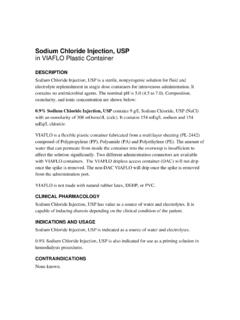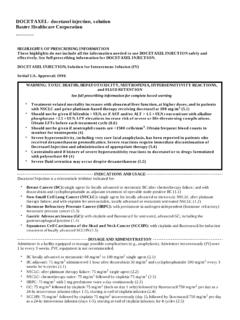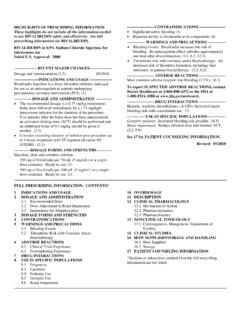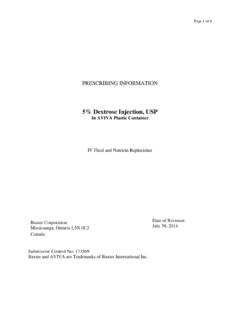Transcription of HIGHLIGHTS OF PRESCRIBING INFORMATION ...
1 HIGHLIGHTS OF PRESCRIBING INFORMATION -------------------------------CONTRAIND ICATIONS------------------------------ These HIGHLIGHTS do not include all the INFORMATION needed to use Pre-existing severe lactic acidosis (4). DIANEAL peritoneal dialysis solutions safely and effectively. See full PRESCRIBING INFORMATION for DIANEAL solutions -----------------------WARNINGS AND PRECAUTIONS------------------------ Encapsulating peritoneal sclerosis ( ). DIANEAL (dextrose) peritoneal dialysis solution Peritonitis: Initiate appropriate antimicrobial therapy ( ). Initial Approval: 1981. DIANEAL PD-2 (dextrose) peritoneal dialysis solution Monitor for lactic acidosis in patients at risk ( ). Initial Approval: 1992 Monitor for electrolyte, fluid, and nutrition imbalances ( ). DIANEAL LOW CALCIUM (dextrose) peritoneal dialysis solution Initial Approval: 1992. To report SUSPECTED ADVERSE REACTIONS, contact Baxter ----------------------------INDICATIONS AND USAGE--------------------------- Healthcare Corporation at 1-866-888-2472 or FDA at 1-800-FDA-1088 or For management of acute or chronic renal failure.
2 ---------------------DOSAGE AND ADMINISTRATION--------------------- See 17 for PATIENT COUNSELING INFORMATION . For intraperitoneal administration only. (2) Revised: [03/2018]. ---------------------DOSAGE FORMS AND STRENGTHS---------------------- DIANEAL solutions are available in multiple combinations of ingredients and in composition, calculated osmolarity, pH, and ionic concentrations. See full PRESCRIBING INFORMATION for detailed descriptions of each formulation. (3). FULL PRESCRIBING INFORMATION : CONTENTS*. 7 DRUG INTERACTIONS. 1 INDICATIONS AND USAGE 8 USE IN SPECIFIC POPULATIONS. 2 DOSAGE AND ADMINISTRATION Pregnancy Basic Dosing INFORMATION Lactation Adding Medications Pediatric Use Directions for Use Geriatric Use 3 DOSAGE FORMS AND STRENGTHS 10 OVERDOSAGE. 4 CONTRAINDICATIONS 11 DESCRIPTION. 5 WARNINGS AND PRECAUTIONS 12 CLINICAL PHARMACOLOGY. Peritonitis and Encapsulating Peritoneal Sclerosis Mechanism of Action Lactic Acidosis Pharmacokinetics Overinfusion 16 HOW SUPPLIED/STORAGE AND HANDLING.
3 Electrolyte, Fluid, and Nutrition Imbalances 17 PATIENT COUNSELING INFORMATION . Hyperglycemia 6 ADVERSE REACTIONS *Sections or subsections omitted from the Full PRESCRIBING INFORMATION are not Clinical Trials Experience listed. Post-Marketing Experience FULL PRESCRIBING INFORMATION . 1 INDICATIONS AND USAGE. DIANEAL peritoneal dialysis solutions are indicated for patients in acute or chronic renal failure. 2 DOSAGE AND ADMINISTRATION. Basic Dosing INFORMATION DIANEAL peritoneal dialysis solutions are intended for intraperitoneal administration only. Not for intravenous administration. Select mode of therapy, frequency of treatment, formulation, fill volume, duration of dwell, and length of dialysis based on the patient's clinical condition, fluid, electrolyte and specific fill volume depends on body size, usually from to liters per for adults. DIANEAL peritoneal dialysis solutions are intended for use in Continuous Ambulatory Peritoneal Dialysis (CAPD).
4 Or Automated Peritoneal Dialysis (APD). Refer to directions accompanying ancillary equipment for CAPD and APD system preparation. Product Selection To avoid the risk of severe dehydration and hypovolemia and to minimize the loss of protein, it is advisable to select the peritoneal dialysis solution with the lowest level of osmolarity consistent with the fluid removal requirements for that exchange. As the patient's body weight becomes closer to the ideal dry weight, lowering the dextrose concentration of DIANEAL solution is recommended. DIANEAL dextrose-containing solution has the highest osmolarity of the DIANEAL solutions and using it for all exchanges may cause dehydration [see Dosage Forms and Strengths (3)]. Adding Medications If the resealable rubber plug on the medication port is missing or partly removed, do not use the product if medication is to be added. To add a medication: 1. Put on mask. Clean and/or disinfect hands.
5 2. Prepare medication port site using aseptic technique. 3. Using a syringe with a 1-inch long, 25- to 19-gauge needle, puncture the medication port and inject additive. 4. Reposition container with container ports up and evacuate medication port by squeezing and tapping it. 5. Mix solution and additive thoroughly. Directions for Use Warming DIANEAL peritoneal dialysis solution can be warmed to 37 C ( F). Only dry heat should be used. For CAPD, it is best to warm solutions within the overwrap using a heating pad. Do not immerse DIANEAL solutions in water for warming. Do not use a microwave oven to warm DIANEAL solutions. To Open To open, tear the overwrap down at the slit and remove the solution container. Do not use sharp objects to remove the overwrap. Product Inspection 2. Parenteral drug products should be inspected visually for particulate matter and discoloration prior to administration. Do not use solutions that are cloudy, discolored, contain visible particulate matter, or show evidence of leakage.
6 Some opacity of the plastic, due to moisture absorption during the sterilization process, may be observed. This does not affect the solution quality or safety and may often leave a slight amount of moisture within the overwrap. The opacity should diminish gradually. Inspect the bag connector to ensure the tip protector (pull ring or blue pull tip) is attached. Do not use if the tip protector is not attached to the connector. Inspect the DIANEAL solution container for signs of leakage and check for minute leaks by squeezing the container firmly. If the container has frangible(s), inspect that they are positioned correctly and are not broken. Do not use DIANEAL solution if the frangible(s) are broken or leaks are suspected as sterility may be impaired. For DIANEAL solutions in ULTRABAG containers, inspect the tubing and drain container for presence of solution. Small droplets are acceptable, but if solution flows past the frangible prior to use, do not use and discard the units.
7 CAPD therapy using ULTRABAG containers Select appropriate formulation from Table 1. Put on mask. Clean and/or disinfect hands. Using aseptic technique;. 1. Uncoil tubing and drain bag, ensuring that the transfer set is closed. 2. Break the connector (Y-set) frangible. 3. Remove the tip protector from connector of solution container. Do not reuse the solution or container once the tip protector is removed. 4. Immediately attach the solution container to patient connector (transfer set). 5. Clamp solution line and then break frangible near solution bag. Hang solution container and place the drainage container below the level of the abdomen. 6. Open transfer set to drain the solution from abdomen. If drainage cannot be established, contact your clinician. When drainage complete, close transfer set. 7. Remove clamp from solution line and flush new solution to flow into the drainage container for 5. seconds to prime the line.
8 Clamp drain line after flush complete. 8. Open transfer set to fill. When fill complete, close transfer set. 9. Disconnect ULTRABAG container from transfer set and apply MINICAP disconnect cap. 10. Upon completion of therapy, discard any unused portion. APD therapy using AMBU-FLEX containers with pull rings or plastic containers with blue pull tips or pull rings Select appropriate formulation from Table 1, 2 or 3. Put on mask. Clean and/or disinfect hands. Using aseptic technique;. 1. Remove the tip protector from connector of solution container. Do not reuse the solution or container once the tip protector is removed. 2. Immediately attach the solution container to an appropriate automated peritoneal dialysis set. 3. Continue therapy as instructed in user manual or directions accompanying tubing sets for automated peritoneal dialysis. 4. Upon completion of therapy, discard any unused portion. 3. 3 DOSAGE FORMS AND STRENGTHS.
9 DIANEAL peritoneal dialysis solution is formulated with the following ionic concentrations: Table 1 - DIANEAL PD-2 and Low Calcium Peritoneal Dialysis Solution ULTRABAG Container for CAPD therapy AMBU-FLEX Container with pull ring for APD therapy Ionic Concentration (mOsmol/L) (calc). OSMOLARITY. (mEq/L). Magnesium Chloride Calcium Sodium Lactate pH. DIANEAL PD-2 346 132 96 40. Dextrose ( to ). DIANEAL PD-2 396 132 96 40. Dextrose ( to ). DIANEAL PD-2 485 132 96 40. Dextrose ( to ). DIANEAL Low Calcium ( mEq/L) 344 132 95 40. Dextrose ( to ). DIANEAL Low Calcium ( mEq/L) 395 132 95 40. Dextrose ( to ). DIANEAL Low Calcium ( mEq/L) 483 132 95 40. Dextrose ( to ). 4. Table 2 - DIANEAL Low Calcium Peritoneal Dialysis Solution Plastic container with blue pull tip for APD therapy Ionic Concentration (mEq/L). OSMOLARITY. Magnesium (mOsmol/L). Chloride Calcium (calc). Sodium Lactate pH. DIANEAL Low Calcium ( mEq/L) 344 to 132 95 40.
10 Dextrose DIANEAL Low Calcium ( mEq/L) 395 to 132 95 40. Dextrose DIANEAL Low Calcium ( mEq/L) 483 to 132 95 40. Dextrose Table 3 - DIANEAL Low Calcium Peritoneal Dialysis Solution Plastic container with pull ring for APD therapy Ionic Concentration (mEq/L). OSMOLARITY. Magnesium (mOsmol/L). Chloride Calcium (calc). Sodium Lactate pH. DIANEAL Low Calcium ( mEq/L) 344 to 132 95 40. Dextrose DIANEAL Low Calcium ( mEq/L) 395 to 132 95 40. Dextrose 4 CONTRAINDICATIONS. DIANEAL peritoneal dialysis solutions are contraindicated in patients with severe lactic acidosis. 5 WARNINGS AND PRECAUTIONS. Peritonitis and Encapsulating Peritoneal Sclerosis Peritonitis has been associated with DIANEAL peritoneal dialysis solution use. Following use, inspect the drained fluid for the presence of fibrin or cloudiness, which may indicate the presence of peritonitis. Improper clamping or priming sequence may result in infusion of air into the peritoneal cavity, which may result in abdominal pain and/or peritonitis.








